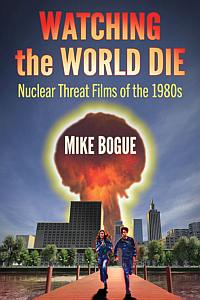Already in the 1950s, apart from science-fiction movies following aliens from outer space invasion plots, disaster films or creature horror, another genre was equally prominent in the list of sensational productions: the nuclear threat films.
 Those were a familiar feature of popular culture, and audiences could watch new movies of the kind until roughly the mid-60s. Then, with other major developments in the US, such as the Vietnam War, and the Civil Rights Movement, interest in the genre suddenly faded. “From 1966 to 1979, the public gave little thought to World War III,” concludes author Douglas Bogue, a retired educator living in Ozark, Arkansas.
Those were a familiar feature of popular culture, and audiences could watch new movies of the kind until roughly the mid-60s. Then, with other major developments in the US, such as the Vietnam War, and the Civil Rights Movement, interest in the genre suddenly faded. “From 1966 to 1979, the public gave little thought to World War III,” concludes author Douglas Bogue, a retired educator living in Ozark, Arkansas.
The probability for atomic warfare between the US and Russia, in the mind of the public, was renewed in the 1980s, a decade that saw a revival of massive tensions between at least those two superpowers, both in possession of nuclear weapons. Russia, called “the evil empire” by President Reagan, and the fear of a Russian missile attack on American ground reached several stages of hysteria. This new anxiety of a worldwide conflict and the destruction following such attacks not only fueled the imaginations of millions of people in the East and the West, but it also spawned hundreds of movies, that painted devastating pictures of a changed world after the Armageddon. And how mankind, both in small communities or as society as such would survive and at what costs. Numerous films of the decade presented possible scenarios after WWIII, and so far those were not subject of a book. Bogue, who in 2017 already presented the survey American and Japanese Atomic Cinema of the 1950s and 1960s, now comes up with the first title on this peculiar genre of the 1980s.
His focus here is different, as the films selected need to meet certain requirements for inclusion in this publication. The productions require to be in one of these four categories: „(1) plausible near-future scenarios; post-apocalyptic action adventures; (3) comic book tales; and (4) monster yarns.“ The films at hand are not solely American (although the majority is), but from all over the world and also include TV productions.
The most influential and important films of the altogether 121 titles introduced and analyzed here, are from the plausible near-future lot. With some, the focal point and the story are not on the results of a nuclear attack for the entire US or the planet, but audiences followed its results by watching life in a small town, or just a single neighborhood. Other productions (such as the important The Day After (1983) and Threads (1984)) provided the bigger picture, with massive destruction of regions, homes and infrastructure, downtown in ruins, large devastation, results of fallout, radiation poisoning and trauma on man, and sometimes even with lots of bodies presented.
The many post-apocalyptic action flicks, on the other hand, basically used the new dystopian scenario the Blockbuster Mad Max (1979) had audiences familiarized with and simply put a number of action characters in, to produce mostly wild, violent and simple plots that involved tribalism, rallies for food and sex and never asked for the reasons of the state of the world. While the comic-book inspired films featured superheroes and their enemies at the brink of atomic warfare, such as the 1988 films Akira or Superman IV: The Quest for Peace (where Superman fights Nuclear Man). That category also includes several very implausible and fantastic stories such as Red Dawn (1984), where a group of teenagers after a limited nuclear attack violently fights communist invasion troops on their hometown grounds in Colorado.
The monster yarns that sooner or later present a giant creature as the result of nuclear explosions (following a tradition from the 1950s) comprises the fourth category.
Readers expecting long chapters that explain the many different approaches of the mass of films introduced here, will possibly be disappointed. Apart from a concise epilogue and a very short introduction in chapter one “The ‘50s vs. the ‘80s,” such information is part of the individual movie evaluation. Here, cast, outcome, moral lessons, plausibility and relation to other nuclear threat films are dealt with, sometimes in just a few paragraphs, then again, on several pages.
The overall method to organize the twelve chapters is chronological and not by category, each year (up to 1990) lists the respective films that made it into Bogue’s representative selection. The book comes with more than 50 black-white movie stills and film posters and is a fine addition to the study of disaster movies and stories of the 1980s, as the films are informed by the respective zeitgeist, prominent political thought and even fashion.
Needless to say that several scenarios portrayed here still can possibly happen, in one way or another, as long as there are nukes around.
Review by Dr. A. Ebert (2024)
Mike Bogue. Watching the World Die. Nuclear Threat Films of the 1980s. McFarland, 2023, 269 p.
